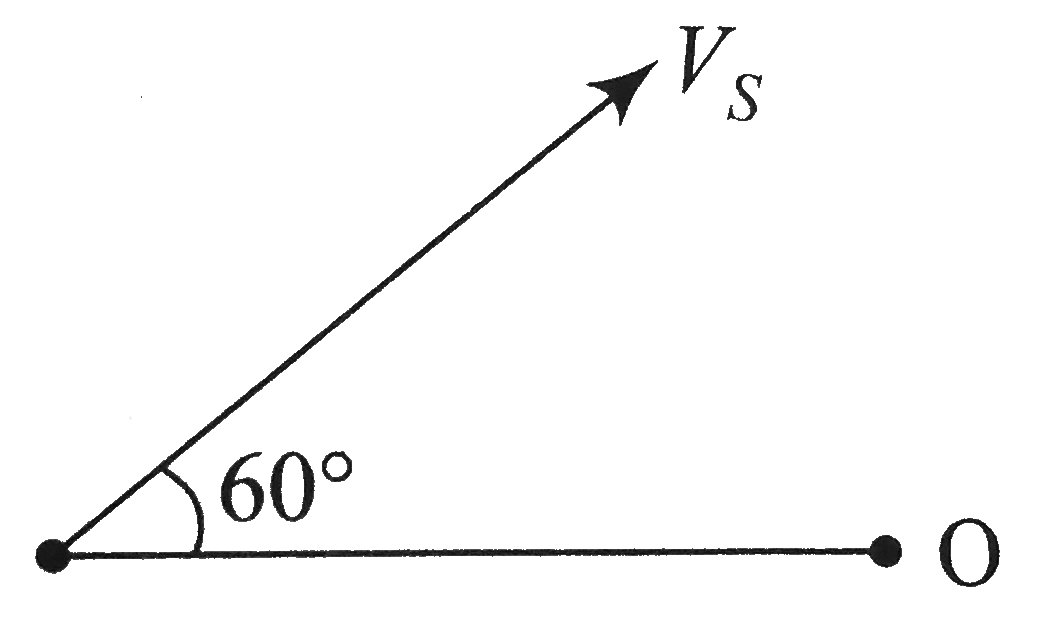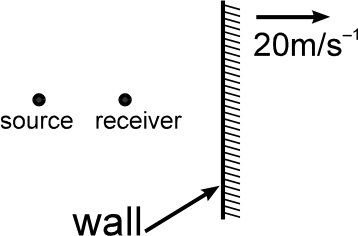A source S of sound wave of fixed frequency N and an observer O are located in air initially at the space points A and B, a fixed distance apart. State in which of the following cases, the observer will NOT see any Doppler effect and will receive the same frequency N as produced by the source.
Both the source S and observer O remain stationary but a wind blows with a constant speed in an arbitrary direction.
The observer remains stationary but the source S moves parallel to and in the same direction and with the same speed as the wind.
The source remains stationary but the observer and the wind have the same speed away from the source.
The source and the observer move directly against the wind but both with the same speed.
The correct Answer is:A, D
In both case (a) and (d) the source and observer are relatively at rest, thus neither of htem is approaching or separating from each other. Effectively, it is the medium that moves in each of these cases. The received (apparent) frequency differs from the emitted frequency if and only if the time required for the wave to travel from the source to observer is different fror different wavefronts. With a uniform steady motion of the medium, past the observer and source, the transit time from source to observer is the same for all wavefronts. Hence it follows that apparent freqeuncy is equal to the true emitted frequency. Thus there is no Doppler effect. In cases (b) and (c ), Doppler effect will be observed as the source and observer have a relative speed and so they will approach or recede from each other.
Topper's Solved these Questions
- BOOK - CENGAGE PHYSICSCHAPTER - SOUND WAVES AND DOPPLER EFFECTEXERCISE - Assertion-Reasoning24videos
SOUND WAVES AND DOPPLER EFFECT
- BOOK - CENGAGE PHYSICSCHAPTER - SOUND WAVES AND DOPPLER EFFECTEXERCISE - Comprehension144videos
SOUND WAVES AND DOPPLER EFFECT
- BOOK - CENGAGE PHYSICSCHAPTER - SOUND WAVES AND DOPPLER EFFECTEXERCISE - Single Correct252videos
SOUND WAVES AND DOPPLER EFFECT
- BOOK - CENGAGE PHYSICSCHAPTER - RIGID BODY DYNAMICS 2EXERCISE - Interger2videos
RIGID BODY DYNAMICS 2
- BOOK - CENGAGE PHYSICSCHAPTER - SUPERPOSITION AND STANDING WAVESEXERCISE - Comprehension Type5videos
SUPERPOSITION AND STANDING WAVES
Similar Questions
A source of sound and an observer, both are moving with the same speed, in the same direction. Will there be any Doppler effect observed by the observer ?
View SolutionA source of sonic oscillations of frequency n0=2000Hz and a receiver are located on the same normal to a wall. Both the source and the receiver are stationary and the wall recedes from the source with a velocity u=10cm/s. Find the beat frequency registered by the receiver. The velocity of sound is v=340m/s
View Solution
Knowledge Check
- Question 1 - Select One

A source of sound S emitting waves of frequency 100Hz and an observer O are located at some distance from each other. The source is moving with a speed of 19.4ms−1 at an angle of 60∘ with the source observer line as shown in the figure. The observer is at rest. The apparent frequency observed by the observer (velocity of sound in air 330ms−1) isA97HzB100HzC103HzD106Hz - Question 2 - Select One

A source of sound S emitting waves of frequency 100Hz and an observer O are located at some distance from each other. The source is moving with a speed of 19.4ms−1 at an angle of 60∘ with the source observer line as shown in the figure. The observer is at rest. The apparent frequency observed by the observer (velocity of sound in air 330ms−1) isA103 HzB106 HzC94 HzD100 Hz - Question 3 - Select One
A wave source of frequency v and an observer are located a fixed distance apart. Both the source and observer are stationary. However, the propagation medium (through which the waves travel at speed v) is moving at a uniform velocity vm in an arbitrary direction. If v' is the frequency received by the observer then :
Av'≠vBv'=v as the transit time from source to observer is the same for all wave frontsCv'<v as the transit time from source to observer is the same for all wave frontsDData Insufficient
A source of sound of frequency 300 Hz and a receiver are located along the same line normal to the wall as shown in the figure. Both the source and the receiver are stationary and the wall receeds from the source with velocity 20ms−1.If the beat frequency registered by the receiver is 240x Hz then x is :
(Assume Vsound=300 m/s).
 View Solution
View SolutionA source of sonic oscillations with frequency n=1700Hz and a receiver are located on the same normal to a wall. Both the source and receiver are stationary, and the wall recedes from the source with velocity u=6.0ms. Find the beat frequency registered by the receiver. The velocity of sound is v=340ms.
View SolutionA source of sound and an observer are approaching each other with the same speed which is equal to 110 times the speed of sound. The apparent change in the frequency of the source is
View SolutionA source of frequency n and an observer are moving on a straight line with velocities a and b respectively. If the source is ahead of the observer and if the medium is also moving in the direction of their motion with velocity c, (the velocity of sound being V), then the apparent frequency of the sound heard by the observer would be -
View SolutionThe graph between distance between source and observer and apparent frequency in the case of Doppler's effect will be
View Solution

